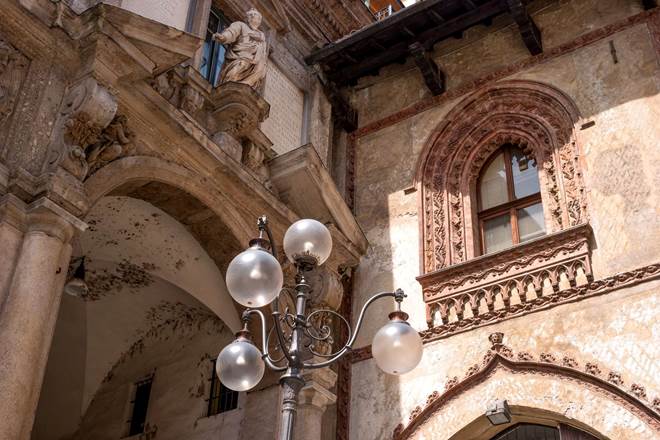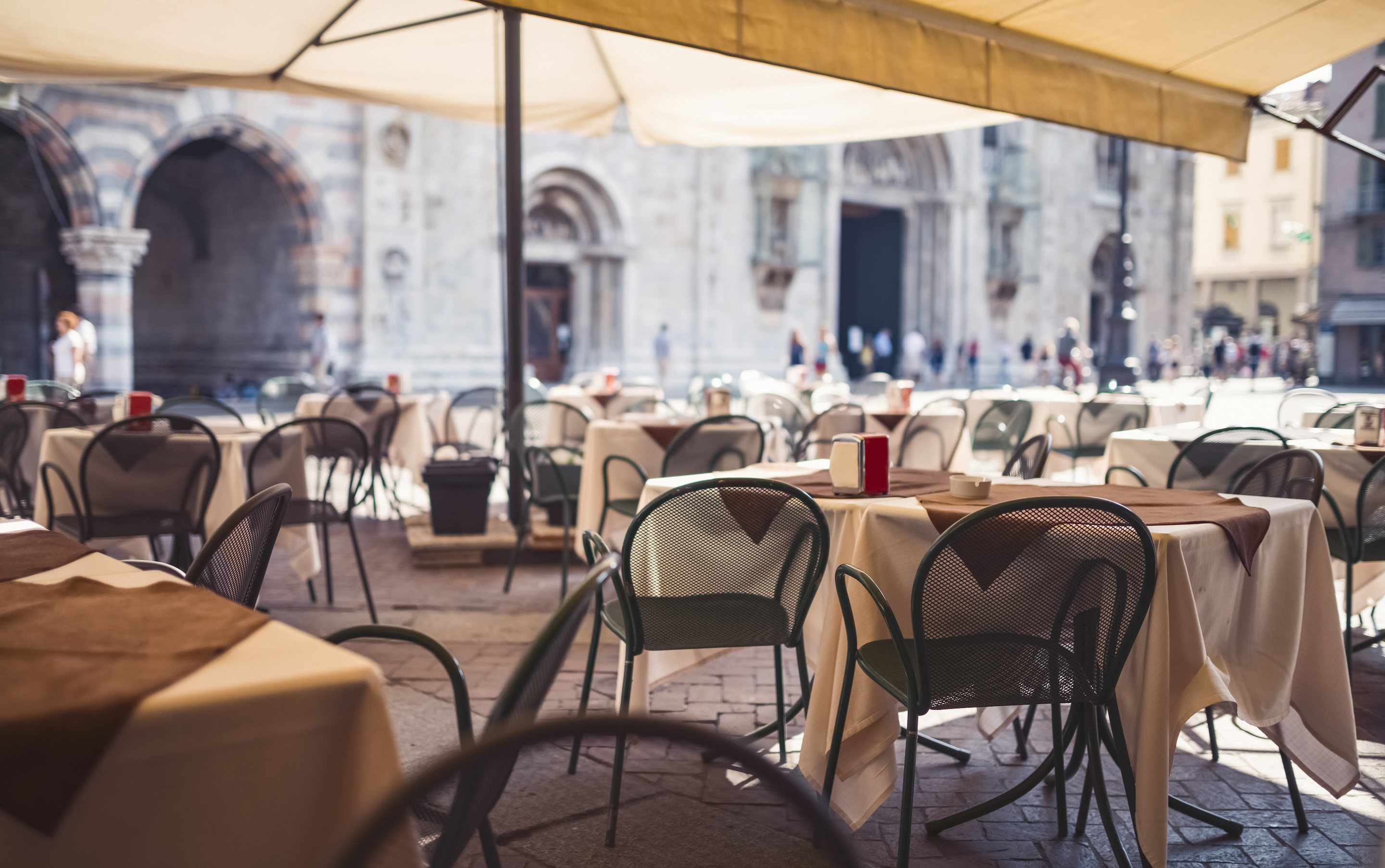Widely considered one of Milan’s most beautiful squares, Piazza Mercanti (The Merchant’s Square) is a place to admire history away from the crowds. Home to some first-class examples of medieval architecture, head to this square to glimpse into historical Milanese life.
Located near Duomo di Milano (Milan Cathedral), Piazza Mercanti was once the capital’s centre but is now a rare tranquil spot in Mi1 (Milan Zone 1). Nestled between Piazza del Duomo (Cathedral Square) and Piazza Cordusio, this was once Milan's bustling commercial and government hub.
What’s in this guide?
- What to see at Piazza Mercanti
- Piazza Mercanti history and facts
- Restaurants, bars and shops nearby
- Opening times and prices
How to get to Piazza Mercanti
Its central location means that it’s easy to reach Piazza Mercanti. Whether you opt for the metro, tram or bus, all modes of Milan’s public transport will be able to take you there.
By metro, take the M1 line to either Cairoli or Corduso. Alternatively, both the M1 and M2 lines stop at Duomo, a 2-minute walk from the square. If an M1 or M2 line isn’t nearby, plenty of trams stop at the nearby Via Orefici, including 2, 3, 12, 14, 16, 19 and 27. If you’re already in the area admiring the Duomo, take a stroll down Via Mercanti, and you’re there!
To spare you from spending half your time on public transport, we’d recommend tackling the other central landmarks whilst you visit Piazza Mercanti. The Duomo, Galleria Vittorio Emanuele II and Santa Maria Presso San Satiro are all a short walk away. It’s a good idea to see them all at once.
If you’re wondering how best to get to the landmarks without spending a fortune, we’d recommend getting a travel card as soon as you reach Milan. These let you travel on all Milanese public transport as many times as needed within a set timeframe. For those on a city break, the 48-hour card is often best, costing just €8.25.
What to see at Piazza Mercanti
You might assume that a square in a city hasn’t got much to offer, but in the case of Piazza Mercanti, you couldn’t be more wrong. With buildings dating back to the Middle Ages and the 17th century, this landmark area is steeped in history and Italian culture. What’s more impressive is that most buildings remain in beautiful condition.
Palazzo della Ragione
A red-brick building on the north-eastern corner called Palazzo della Ragione (Ragione Palace). It’s also commonly known as Brolette Nuovo.
Inaugurated in 1233, this building was used to house Milan’s courts of justice, with city markets held in its porches. The ground floor was vast and open for meetings of the local residents, whilst upstairs was reserved for Council meetings.
After centuries of use, Palazzo della Ragione was expanded in 1773 thanks to Maria Theresa of Austria, who requested an extra floor. Today, the space is mainly used for exhibitions; the high ceilings make this a perfect space for showcasing works of art.
Loggia degli Osii
The intricately decorated Loggia degli Osii is a real feast for the eyes. It was designed by Scoto da San Gimignano, built on the square’s south-eastern side back in 1316 for Matteo I Visconti. This created a space for Milan’s judicial and notary activities.
What’s unusual about this building is its Gothic façade. The style was often used in Genoa but is uncommon in Lombard buildings. The alternating black and white marble columns create a striking contrast from the surrounding buildings. The large open arches are complete with statues and coats of arms.
The balcony, also known as Parlera, is decorated with an emblem of the Visconti. The symbol shows an eagle and its pray, symbolising justice. You’ll also spot extravagant sculptures of Milan’s saints on the upper floor.
Palazzo delle Scuole Palatine
A 17th-century Baroque-style building, Palazzo delle Scuole Palatine (Palace of the Palatine School) was once the city’s most important school, educating many famous Milanese students. The original ancient building was destroyed in a fire and rebuilt in 1664 by Carlo Buzzi.
On the south-eastern corner of the square, the majestic entrance is flanked by arcades. Above these, look out for a statue of Saint Augustin, who is rumoured to have once taught at the school.
Casa dei Panigarola
Another example of Gothic architecture, this building is now a restaurant but still features the original porches. Also aptly known as Palazzo dei Notai (Palace of the Notaries), Casa dei Panigarola served as a notary seat in the 15th century.
Palazzo dei Giureconsulti
Palazzo dei Giureconsulti (The Giureconsulti Palace) can be found at the exterior part of Piazza Mercanti, in front of Palazzo della Ragione. Designed by Vincenzo Seregni in 1561, this building once housed Milan’s Chamber of Commerce.
The clock tower dates back even further, to the 13th century. It was used to mark Milan’s business hours and announce curfews. You can also find a 19th-century statue of St. Ambrose by Luigi Scorzini here.
Piazza Mercanti history and facts
It may not be the centre of Milan now, but it was a different story back in the Middle Ages. Before Piazza del Duomo, Piazza Mercanti was the city’s beating heart and was considerably larger back then. With the city hall, law courts and prison all in this one square, it really is no surprise that it became Milan’s city centre.
The square had six entry points associated with a specific trade, from tailors to cobblers, blacksmiths and hatmakers. Local residents spent a lot of time in the area, which meant it was also an ideal place to make announcements.
Walk to the centre of the square, and you’ll find a medieval well. A large stone once stood here, which was used to punish and shame those found guilty of bankruptcy.
Right up to the 19th century, the square also played host to Milan’s most traditional fair. Oh bej! Oh bej! is the city’s oldest Christmas market, lasting three days during the first week of December. The event is now much more extensive and therefore had to move to Castello Sforzesco to accommodate the thousands of visitors. But Piazza Mercanti still hosts small Christmas markets to this day.
Restaurants, bars and shops near Piazza Mercanti
While Piazza Mercanti offers respite from tourist crowds, favourite Milanese landmarks are within walking distance. Galleria Vittorio Emanuele II, Duomo, Teatro alla Scala and Pinacoteca Ambrosiana are all just around the corner. So, it’s no surprise that there are plenty of amenities around Piazza Mercanti.
Restaurants
No matter what cuisine you’re after, you’re sure to find a restaurant near this square. If you want to plan ahead, take a look at our top choices.
- La Locanda del Gatto Rosso – If you’re looking for a traditional Milanese restaurant that will give you an authentic dining experience, look no further. La Locanda del Gatto Rosso is a 10-minute walk away in the majestic Galleria Vittorio Emanuele II. The restaurant has a friendly Italian atmosphere, coupled with outstanding food, packed with the staple flavours of Milan
- Cracco – In Galleria Vittorio Emanuele II, Cracco makes a premium backdrop for an exceptional meal. The sophisticated menu boasts oysters, caviar spaghetti and a selection of Spigaroli. This is Italian dining at its very best
- Pavarotti Milano Restaurant Museum – Want to try something different? Head to the restaurant that honours the legendary Italian tenor. The menu is inspired by Modena cuisine, Pavarotti’s home, and features some of the icon’s favourite dishes. Team this with live music and memorabilia, and you have a fully immersive experience
Bars
You might want a cocktail bar for a classy evening or just somewhere for a mid-afternoon drink. Whatever you’re looking for, there are many bars to choose from surrounding Piazza Mercanti.
- The Dome – Head here for one of the best rooftop bars the city has to offer. Offering views of the Duomo and beyond, The Dome is the idyllic place to enjoy a drink of your choice after a long day seeing the Milan sights
- Ronchi 78 – The city's first Italian wine bar is just over a 5-minute walk from Piazza Mercanti. Established in 1934, Ronchi 78 celebrates Milan in a warm, friendly setting. Enjoy your Italian wine with live music, the best way of bringing your evening to an end
- GB Bar – If you’re on the hunt for a leisurely lunch, head to GB Bar. Less than 10 minutes from Piazza Mercanti, you can grab a drink with a classic sandwich – lunch done right
Shopping
It’s hard to resist a good shopping spree when on a city break, especially when you happen to be in one of the world’s fashion capitals. Milan is famous for its unbeatable shops; expect nothing less when shopping around Piazza Mercanti.
- Galleria Vittorio Emanuele II – You can’t go sightseeing around the Duomo without visiting Galleria Vittorio Emanuele II. Not just a great place to splurge on a designer item, this shopping arcade should be at the top of your sightseeing checklist. As one of the most iconic images of Milan, you really must see it and take in the grand décor
- Via Alessandro Manzoni – Take a 10-minute walk from Piazza Mercanti, and you’ll find yourself at the foot of Via Alessandro Manzoni. Here you can carry on with your high-end shopping, away from the busy tourist crowds
- Via della Spiga – On the hunt for a quainter shopping street? Head to Via della Spiga. You’ll still find the top brands here, as well as independent boutiques, all set in beautiful Victorian terraces
Opening times and prices
Visitors can roam Piazza Mercanti free of charge, and what’s even better is that you can visit any time of day, seven days a week!
If you’re unsure of what time to visit, how about during the afternoon? Often the peak time for the busy surrounding landmarks, we’d recommend you tick off the likes of the Duomo in the morning, then take refuge in Piazza Mercanti later in the day.
Travelling by train to Milan?
If you're thinking of taking a trip to Milan, why not travel by train? Getting the train to Milan is easy thanks to the high-speed rail connections operated by Trenitalia and Italo. You can travel to Milan from some of the most popular cities in Italy, including from Venice to Milan (2h), Rome to Milan (2h 52m) and Florence to Milan (1h 40m).
Need more information about travelling to Milan by train? Check out our dedicated page to trains to Milan.


